HYUNDAI ENTOURAGE 2009 Workshop Manual
Manufacturer: HYUNDAI, Model Year: 2009, Model line: ENTOURAGE, Model: HYUNDAI ENTOURAGE 2009Pages: 402, PDF Size: 9.08 MB
Page 51 of 402
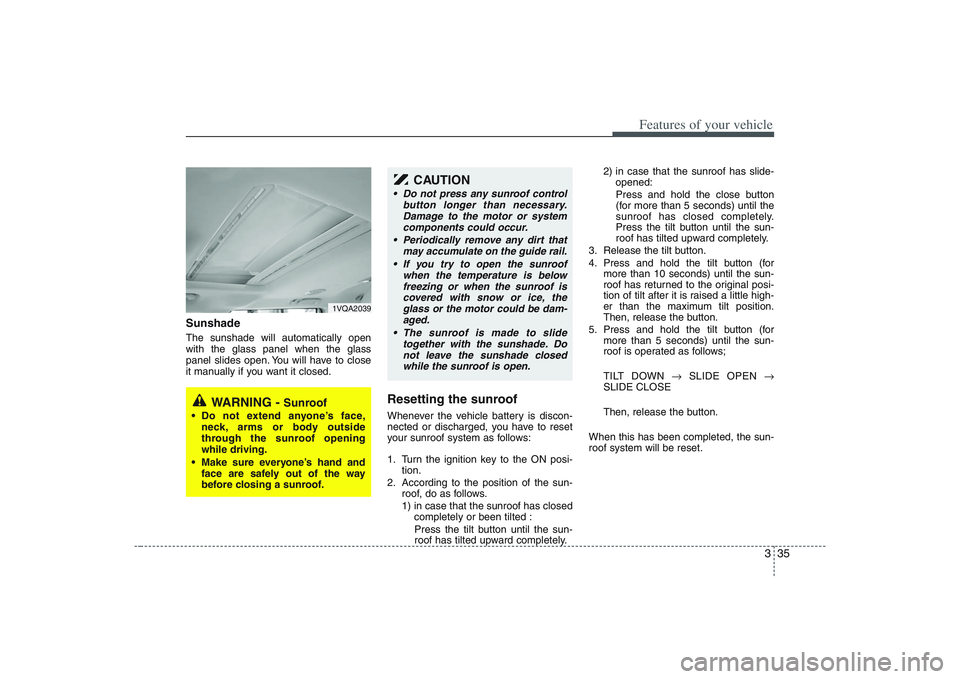
335
Features of your vehicle
Sunshade The sunshade will automatically open
with the glass panel when the glass
panel slides open. You will have to close
it manually if you want it closed.
Resetting the sunroofWhenever the vehicle battery is discon-
nected or discharged, you have to reset
your sunroof system as follows:
1. Turn the ignition key to the ON posi-
tion.
2. According to the position of the sun-
roof, do as follows.
1) in case that the sunroof has closed
completely or been tilted :
Press the tilt button until the sun-
roof has tilted upward completely.2) in case that the sunroof has slide-
opened:
Press and hold the close button
(for more than 5 seconds) until the
sunroof has closed completely.
Press the tilt button until the sun-
roof has tilted upward completely.
3. Release the tilt button.
4. Press and hold the tilt button (for
more than 10 seconds) until the sun-
roof has returned to the original posi-
tion of tilt after it is raised a little high-
er than the maximum tilt position.
Then, release the button.
5. Press and hold the tilt button (for
more than 5 seconds) until the sun-
roof is operated as follows;
TILT DOWN →SLIDE OPEN →
SLIDE CLOSE
Then, release the button.
When this has been completed, the sun-
roof system will be reset.
1VQA2039
WARNING -
Sunroof
Do not extend anyone’s face,
neck, arms or body outside
through the sunroof opening
while driving.
Make sure everyone’s hand and
face are safely out of the way
before closing a sunroof.
CAUTION
Do not press any sunroof control
button longer than necessary.
Damage to the motor or system
components could occur.
Periodically remove any dirt that
may accumulate on the guide rail.
If you try to open the sunroof
when the temperature is below
freezing or when the sunroof is
covered with snow or ice, the
glass or the motor could be dam-
aged.
The sunroof is made to slide
together with the sunshade. Do
not leave the sunshade closed
while the sunroof is open.
Page 52 of 402
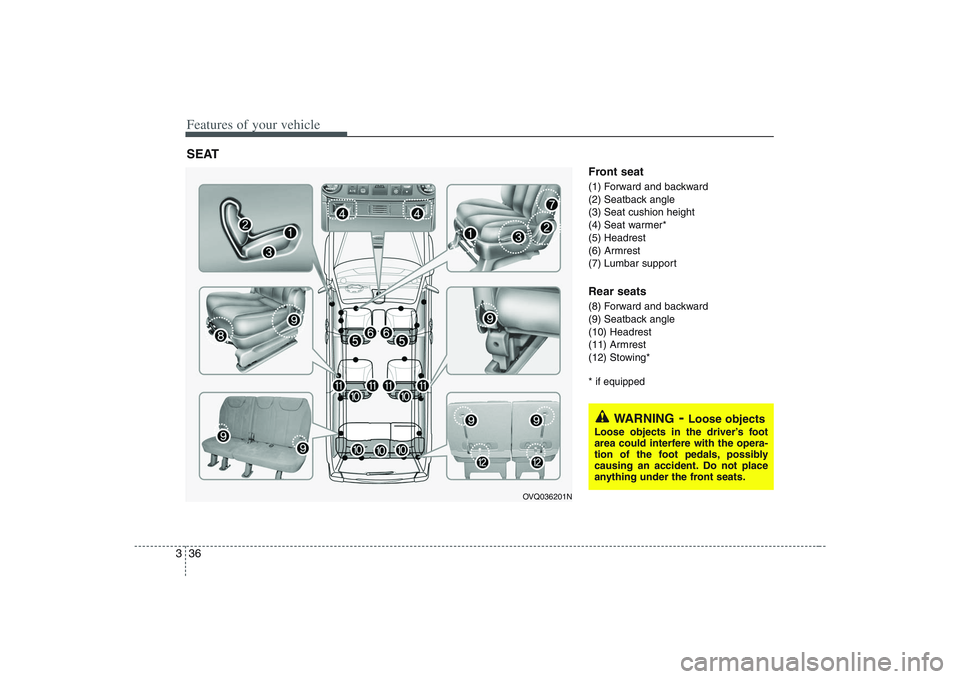
Features of your vehicle36 3
Front seat(1) Forward and backward
(2) Seatback angle
(3) Seat cushion height
(4) Seat warmer*
(5) Headrest
(6) Armrest
(7) Lumbar supportRear seats(8) Forward and backward
(9) Seatback angle
(10) Headrest
(11) Armrest
(12) Stowing** if equipped
SEAT
OVQ036201N
WARNING
- Loose objects
Loose objects in the driver’s foot
area could interfere with the opera-
tion of the foot pedals, possibly
causing an accident. Do not place
anything under the front seats.
Page 53 of 402
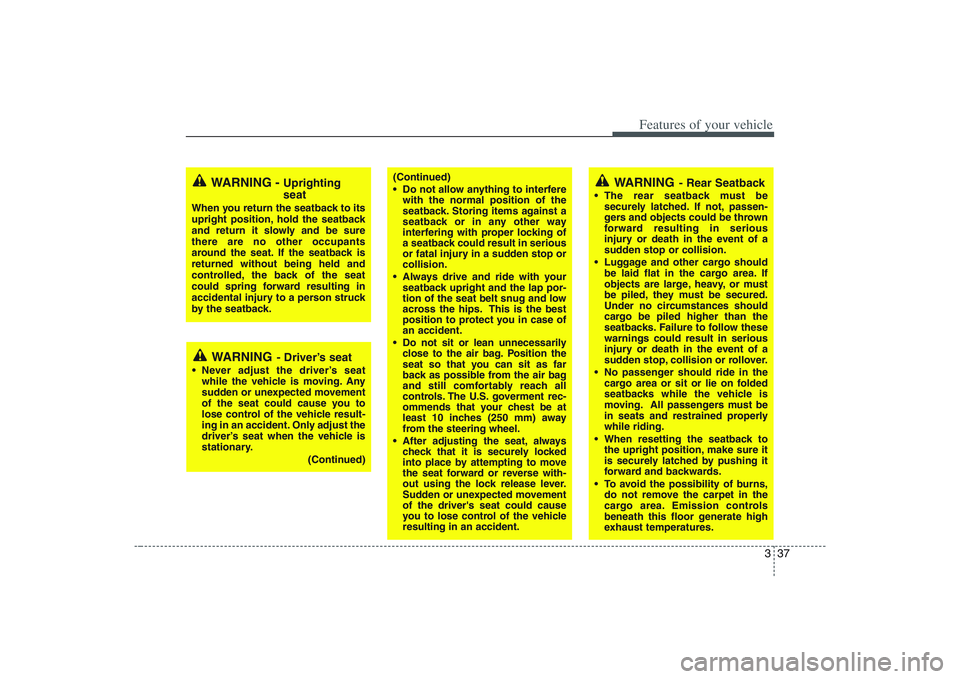
337
Features of your vehicle
WARNING
- Driver’s seat
Never adjust the driver’s seat
while the vehicle is moving. Any
sudden or unexpected movement
of the seat could cause you to
lose control of the vehicle result-
ing in an accident. Only adjust the
driver’s seat when the vehicle is
stationary.
(Continued)
(Continued)
Do not allow anything to interfere
with the normal position of the
seatback. Storing items against a
seatback or in any other way
interfering with proper locking of
a seatback could result in serious
or fatal injury in a sudden stop or
collision.
Always drive and ride with your
seatback upright and the lap por-
tion of the seat belt snug and low
across the hips. This is the best
position to protect you in case of
an accident.
Do not sit or lean unnecessarily
close to the air bag. Position the
seat so that you can sit as far
back as possible from the air bag
and still comfortably reach all
controls. The U.S. goverment rec-
ommends that your chest be at
least 10 inches (250 mm) away
from the steering wheel.
After adjusting the seat, always
check that it is securely locked
into place by attempting to move
the seat forward or reverse with-
out using the lock release lever.
Sudden or unexpected movement
of the driver's seat could cause
you to lose control of the vehicle
resulting in an accident.
WARNING -
Uprighting
seat
When you return the seatback to its
upright position, hold the seatback
and return it slowly and be sure
there are no other occupants
around the seat. If the seatback is
returned without being held and
controlled, the back of the seat
could spring forward resulting in
accidental injury to a person struck
by the seatback.
WARNING
- Rear Seatback
The rear seatback must be
securely latched. If not, passen-
gers and objects could be thrown
forward resulting in serious
injury or death in the event of a
sudden stop or collision.
Luggage and other cargo should
be laid flat in the cargo area. If
objects are large, heavy, or must
be piled, they must be secured.
Under no circumstances should
cargo be piled higher than the
seatbacks. Failure to follow these
warnings could result in serious
injury or death in the event of a
sudden stop, collision or rollover.
No passenger should ride in the
cargo area or sit or lie on folded
seatbacks while the vehicle is
moving. All passengers must be
in seats and restrained properly
while riding.
When resetting the seatback to
the upright position, make sure it
is securely latched by pushing it
forward and backwards.
To avoid the possibility of burns,
do not remove the carpet in the
cargo area. Emission controls
beneath this floor generate high
exhaust temperatures.
Page 54 of 402
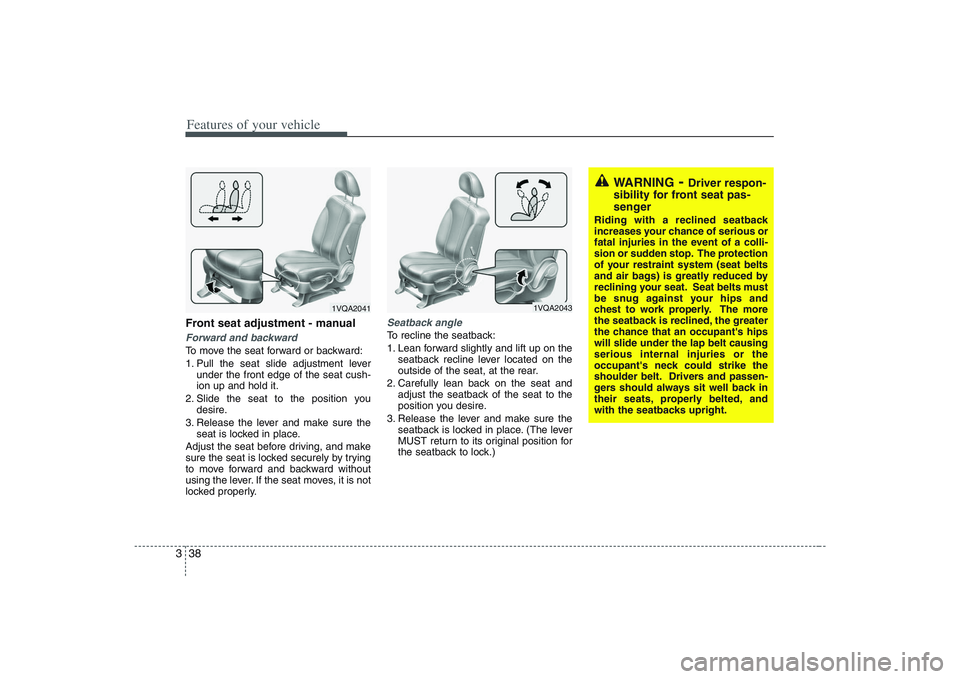
Features of your vehicle38 3Front seat adjustment - manualForward and backwardTo move the seat forward or backward:
1. Pull the seat slide adjustment lever
under the front edge of the seat cush-
ion up and hold it.
2. Slide the seat to the position you
desire.
3. Release the lever and make sure the
seat is locked in place.
Adjust the seat before driving, and make
sure the seat is locked securely by trying
to move forward and backward without
using the lever. If the seat moves, it is not
locked properly.
Seatback angleTo recline the seatback:
1. Lean forward slightly and lift up on the
seatback recline lever located on the
outside of the seat, at the rear.
2. Carefully lean back on the seat and
adjust the seatback of the seat to the
position you desire.
3. Release the lever and make sure the
seatback is locked in place. (The lever
MUST return to its original position for
the seatback to lock.)
1VQA2041
1VQA2043
WARNING
- Driver respon-
sibility for front seat pas-
senger
Riding with a reclined seatback
increases your chance of serious or
fatal injuries in the event of a colli-
sion or sudden stop. The protection
of your restraint system (seat belts
and air bags) is greatly reduced by
reclining your seat. Seat belts must
be snug against your hips and
chest to work properly. The more
the seatback is reclined, the greater
the chance that an occupant's hips
will slide under the lap belt causing
serious internal injuries or the
occupant's neck could strike the
shoulder belt. Drivers and passen-
gers should always sit well back in
their seats, properly belted, and
with the seatbacks upright.
Page 55 of 402
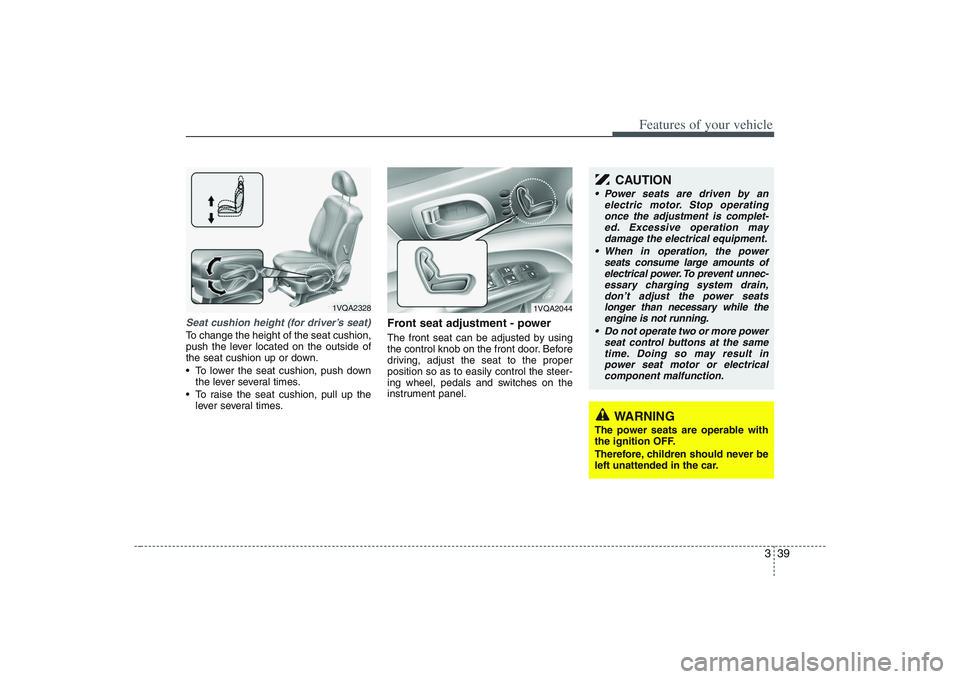
339
Features of your vehicle
Seat cushion height (for driver’s seat)To change the height of the seat cushion,
push the lever located on the outside of
the seat cushion up or down.
To lower the seat cushion, push down
the lever several times.
To raise the seat cushion, pull up the
lever several times.
Front seat adjustment - powerThe front seat can be adjusted by using
the control knob on the front door. Before
driving, adjust the seat to the proper
position so as to easily control the steer-
ing wheel, pedals and switches on the
instrument panel.
1VQA2328
WARNING
The power seats are operable with
the ignition OFF.
Therefore, children should never be
left unattended in the car.
CAUTION
Power seats are driven by an
electric motor. Stop operating
once the adjustment is complet-
ed. Excessive operation may
damage the electrical equipment.
When in operation, the power
seats consume large amounts of
electrical power. To prevent unnec-
essary charging system drain,
don’t adjust the power seats
longer than necessary while the
engine is not running.
Do not operate two or more power
seat control buttons at the same
time. Doing so may result in
power seat motor or electrical
component malfunction.
1VQA2044
Page 56 of 402
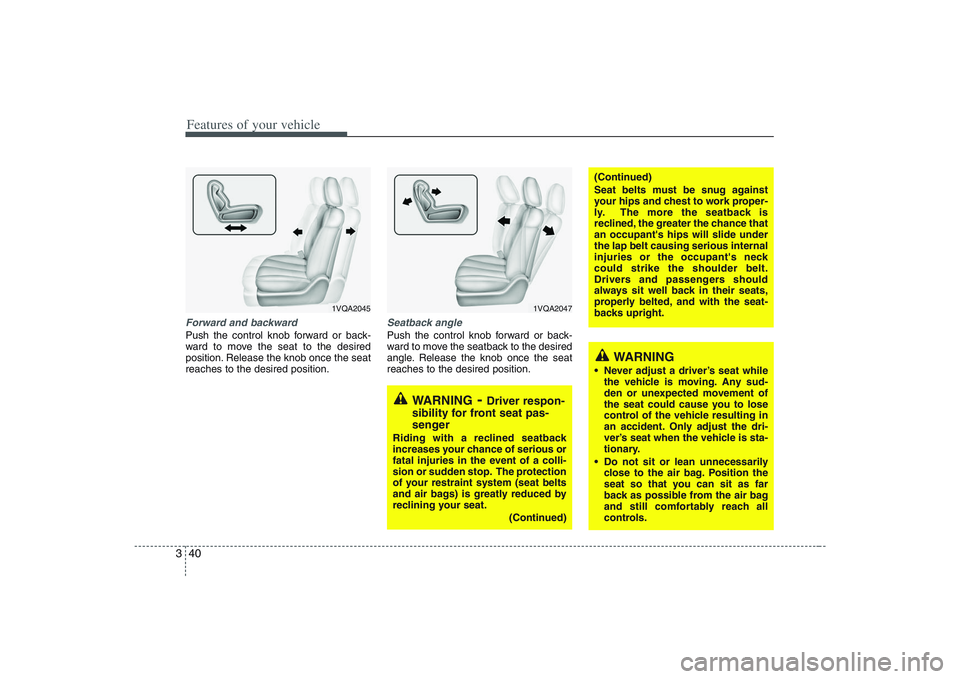
Features of your vehicle40 3Forward and backward Push the control knob forward or back-
ward to move the seat to the desired
position. Release the knob once the seat
reaches to the desired position.
Seatback anglePush the control knob forward or back-
ward to move the seatback to the desired
angle. Release the knob once the seat
reaches to the desired position.
1VQA2045
1VQA2047
WARNING
- Driver respon-
sibility for front seat pas-
senger
Riding with a reclined seatback
increases your chance of serious or
fatal injuries in the event of a colli-
sion or sudden stop. The protection
of your restraint system (seat belts
and air bags) is greatly reduced by
reclining your seat.
(Continued)
(Continued)
Seat belts must be snug against
your hips and chest to work proper-
ly. The more the seatback is
reclined, the greater the chance that
an occupant's hips will slide under
the lap belt causing serious internal
injuries or the occupant's neck
could strike the shoulder belt.
Drivers and passengers should
always sit well back in their seats,
properly belted, and with the seat-
backs upright.
WARNING
Never adjust a driver’s seat while
the vehicle is moving. Any sud-
den or unexpected movement of
the seat could cause you to lose
control of the vehicle resulting in
an accident. Only adjust the dri-
ver’s seat when the vehicle is sta-
tionary.
Do not sit or lean unnecessarily
close to the air bag. Position the
seat so that you can sit as far
back as possible from the air bag
and still comfortably reach all
controls.
Page 57 of 402
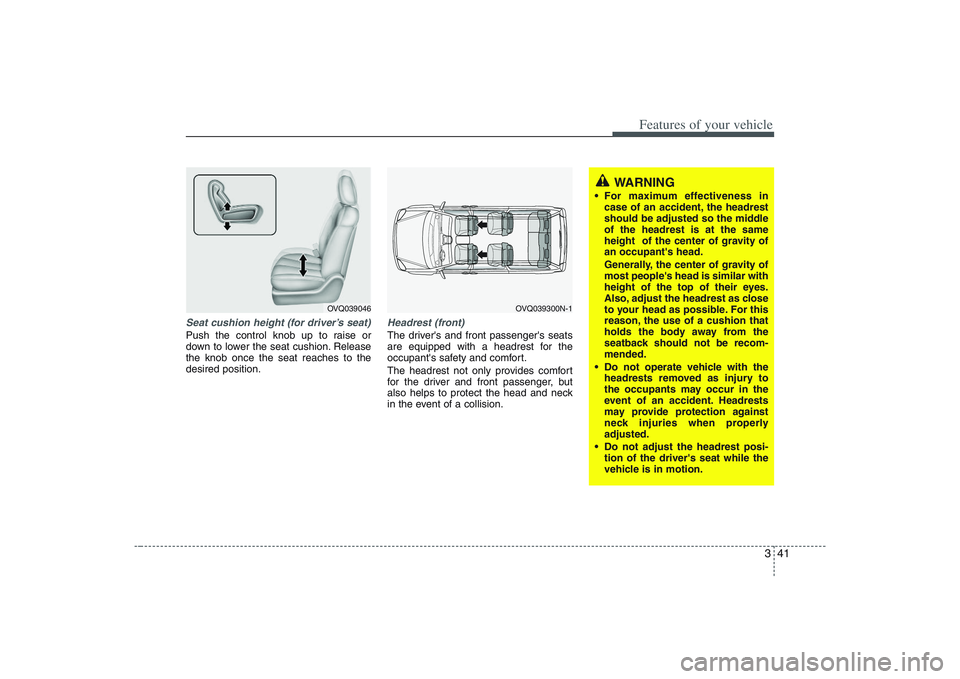
341
Features of your vehicle
Seat cushion height (for driver’s seat)Push the control knob up to raise or
down to lower the seat cushion. Release
the knob once the seat reaches to the
desired position.
Headrest (front)The driver's and front passenger's seats
are equipped with a headrest for the
occupant's safety and comfort.
The headrest not only provides comfort
for the driver and front passenger, but
also helps to protect the head and neck
in the event of a collision.
OVQ039046
OVQ039300N-1
WARNING
For maximum effectiveness in
case of an accident, the headrest
should be adjusted so the middle
of the headrest is at the same
height of the center of gravity of
an occupant's head.
Generally, the center of gravity of
most people's head is similar with
height of the top of their eyes.
Also, adjust the headrest as close
to your head as possible. For this
reason, the use of a cushion that
holds the body away from the
seatback should not be recom-
mended.
Do not operate vehicle with the
headrests removed as injury to
the occupants may occur in the
event of an accident. Headrests
may provide protection against
neck injuries when properly
adjusted.
Do not adjust the headrest posi-
tion of the driver's seat while the
vehicle is in motion.
Page 58 of 402
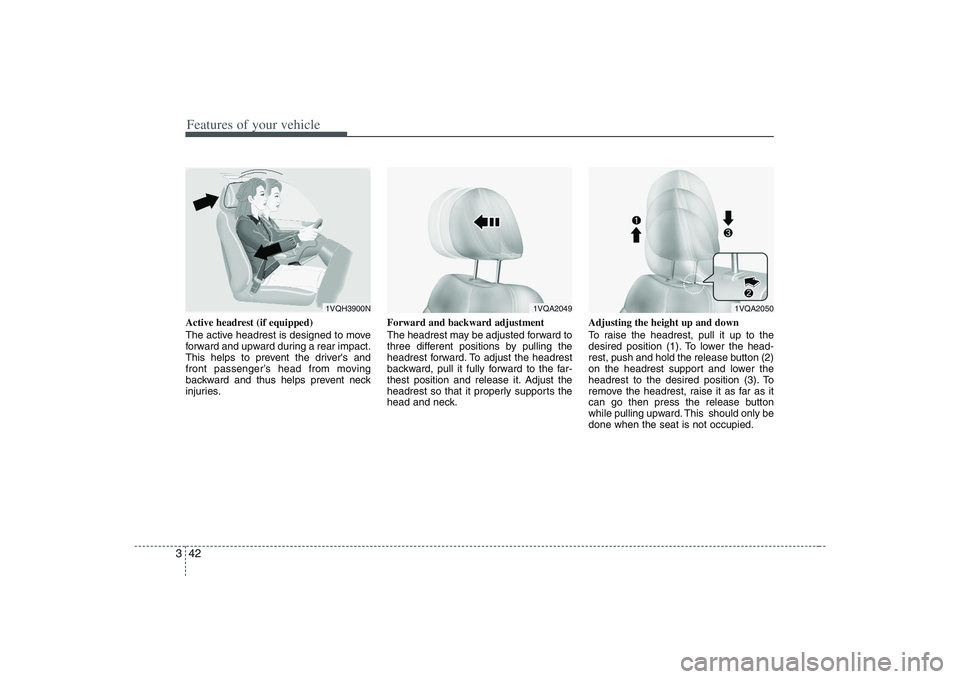
Features of your vehicle42 3Active headrest (if equipped)
The active headrest is designed to move
forward and upward during a rear impact.
This helps to prevent the driver's and
front passenger’s head from moving
backward and thus helps prevent neck
injuries.Forward and backward adjustment
The headrest may be adjusted forward to
three different positions by pulling the
headrest forward. To adjust the headrest
backward, pull it fully forward to the far-
thest position and release it. Adjust the
headrest so that it properly supports the
head and neck.Adjusting the height up and down
To raise the headrest, pull it up to the
desired position (1). To lower the head-
rest, push and hold the release button (2)
on the headrest support and lower the
headrest to the desired position (3). To
remove the headrest, raise it as far as it
can go then press the release button
while pulling upward. This should only be
done when the seat is not occupied.
1VQA2050
1VQA2049
1VQH3900N
Page 59 of 402
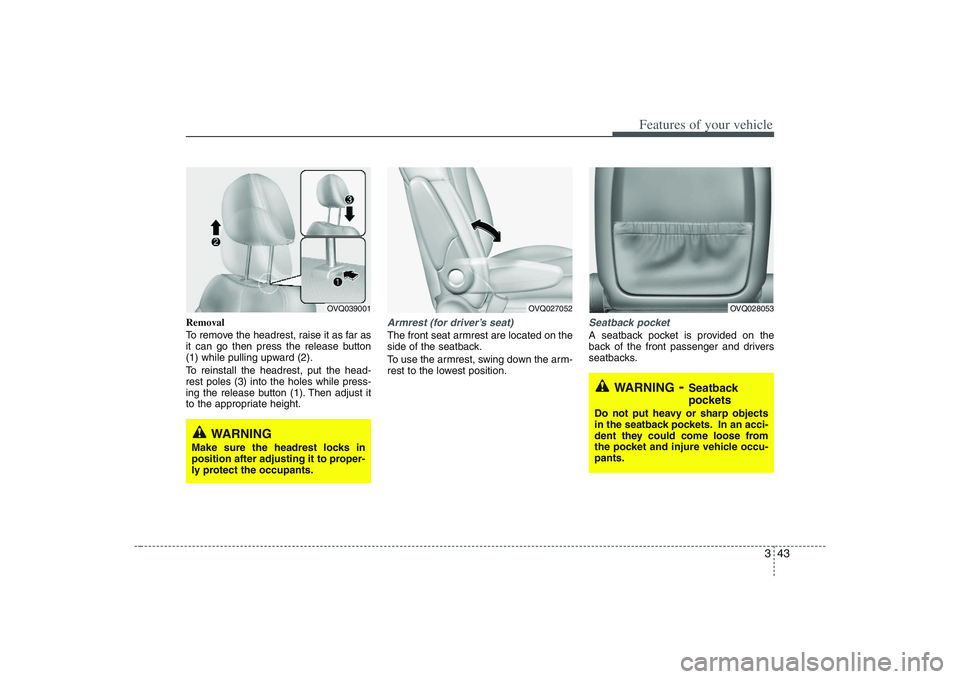
343
Features of your vehicle
Removal
To remove the headrest, raise it as far as
it can go then press the release button
(1) while pulling upward (2).
To reinstall the headrest, put the head-
rest poles (3) into the holes while press-
ing the release button (1). Then adjust it
to the appropriate height.
Armrest (for driver’s seat)The front seat armrest are located on the
side of the seatback.
To use the armrest, swing down the arm-
rest to the lowest position.
Seatback pocketA seatback pocket is provided on the
back of the front passenger and drivers
seatbacks.
OVQ039001
WARNING
Make sure the headrest locks in
position after adjusting it to proper-
ly protect the occupants.
OVQ027052
WARNING
- Seatback
pockets
Do not put heavy or sharp objects
in the seatback pockets. In an acci-
dent they could come loose from
the pocket and injure vehicle occu-
pants.
OVQ028053
Page 60 of 402
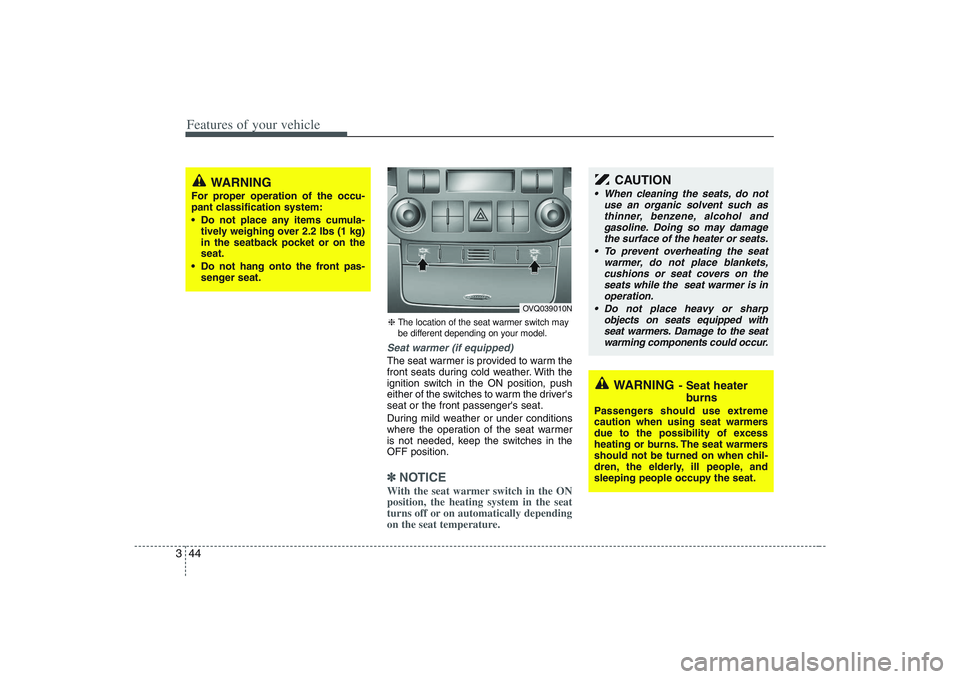
Features of your vehicle44 3
Seat warmer (if equipped)The seat warmer is provided to warm the
front seats during cold weather. With the
ignition switch in the ON position, push
either of the switches to warm the driver's
seat or the front passenger's seat.
During mild weather or under conditions
where the operation of the seat warmer
is not needed, keep the switches in the
OFF position.✽ ✽
NOTICEWith the seat warmer switch in the ON
position, the heating system in the seat
turns off or on automatically depending
on the seat temperature.
WARNING
For proper operation of the occu-
pant classification system:
Do not place any items cumula-
tively weighing over 2.2 lbs (1 kg)
in the seatback pocket or on the
seat.
Do not hang onto the front pas-
senger seat.
❈The location of the seat warmer switch may
be different depending on your model.
OVQ039010N
WARNING
- Seat heater
burns
Passengers should use extreme
caution when using seat warmers
due to the possibility of excess
heating or burns. The seat warmers
should not be turned on when chil-
dren, the elderly, ill people, and
sleeping people occupy the seat.
CAUTION
When cleaning the seats, do not
use an organic solvent such as
thinner, benzene, alcohol and
gasoline. Doing so may damage
the surface of the heater or seats.
To prevent overheating the seat
warmer, do not place blankets,
cushions or seat covers on the
seats while the seat warmer is in
operation.
Do not place heavy or sharp
objects on seats equipped with
seat warmers. Damage to the seat
warming components could occur.